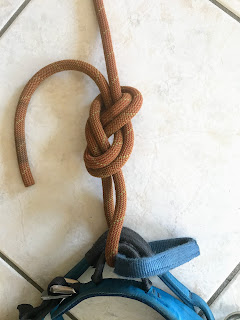Finding flow
Work logistics into your course planning. At each step, where will you be, with what gear and in what mental state?
During any climbing course, we have a lot of ground to cover, and I mean a lot. At the same time, we want a stress-free and safe learning environment with time for laughs. So where can we cut corners and shave off that hour we so sorely need on Sunday afternoon? How can we minimize "non-learning time"?
Where I climb and teach climbing, a climbing course usually takes two days. If we look at the beginner's course that we (the Swedish Climbing Federation) offer, it covers top rope anchor construction, top-rope climbing, belaying, rappels, and many more bits and pieces. If we take a Rescue 1, we need to cover hoists, counter-weight rappelling, "packaging" an injured climber, moving an injured climber in non-technical terrain, multi-pitch rappelling with an injured climber, and a lot more.
Whichever way you look at it, it´s going to be a busy weekend. And you cannot speed things up by talking faster (more about that here).
The single most important thing to work on is your logistics. In what order are you going to do things? At each step, where will you be, with what gear and in what mental state?
By its very nature, climbing involves a lot of climbing up and down. At my crag, I have the luxury of plenty of good spots where it is possible to walk off. I choose these spots because it simplifies things for me, especially when I must rig a zillion ropes in the morning and need to get all the gear to the top (and back down in the evening).
During the actual course, however, the goal is to minimize walking. This means combining exercises so that we alternate between moving up and down the cliff. Take, for example, a rappel exercise. It ends at the bottom. Here, you transition to a segment where the participants ascend the rope on prussiks. Ideally, you can even make this a realistic scenario; we pretend the ropes get stuck after rappelling, talk about what the options are, and then suggest prussiking up to free them.
Carefully weaving these considerations into your course plan will ensure minimum down-time as well as a natural transitions between course segments. This, in turn, means that there will be time for a quick coffee break when needed, or time for extra questions, or putting a band-aid on a cut. By being efficient, we give ourselves some slack.
As a side note: another reason to avoid scrambling up and down the side of a crag is that it invites accidents. While on the face, students are always protected by a bullet-proof system, and everyone is focused. But when hiking up scree or muddy trails, even a minor slip can mean that somebody gets hurt and needs to be evacuated in terrain that suddenly is very challenging. At all costs, avoid this.
None of this should be taken as meaning that all walking is bad. After a long morning hanging off the ropes practising rescue in an icy drizzle, students can really need a brisk uphill walk to get warm. And if the time is right, the walk can be used for a quick theory lesson about access issues, backpacks, or nutrition. The point is that this should be part of your plan, not something that just happens because of sloppy preparation.
Work a smooth flow of exercises into your course already at the planning stage. The participants will never thank you for this; all they will know is they had a great weekend and learned tons of new stuff with no stress! Your reward, as you pack up the ropes and head home after a couple of days at the crag, is the feeling that you nailed it.



Comments
Post a Comment